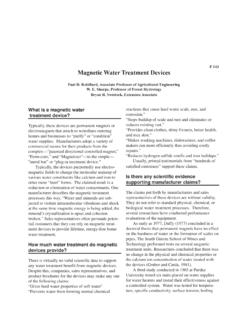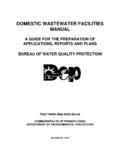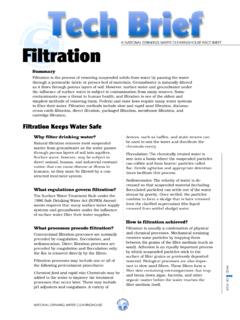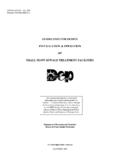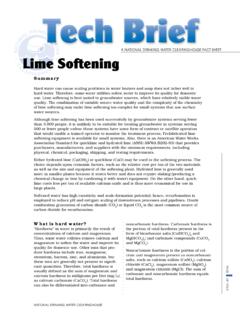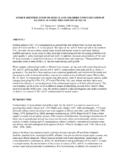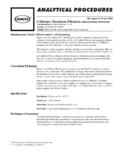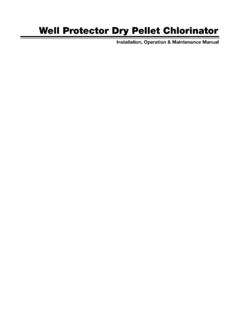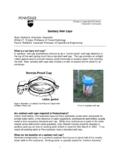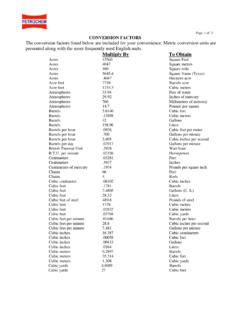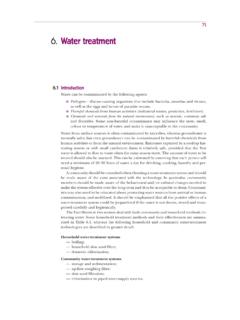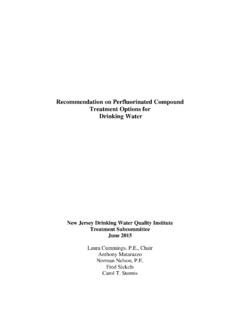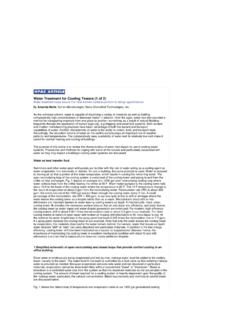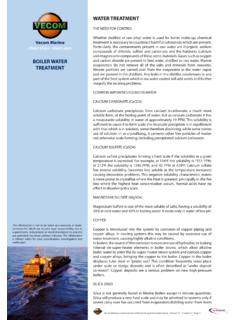Transcription of Drinking Water Facts….. Drinking Water Treatment …
1 By Barbara Daniels and Nancy Mesner June, 2005 If your home Water comes from a public Water supply, it has been tested and meets EPA standards for Drinking Water . If you use a private well, however, you are responsible for assuring that the Water is safe to drink. This means that you should periodically have your Water tested, make sure your well is in proper condition without faulty well caps or seals, and identify and remove potential sources of contamination to your well such as leaking septic systems or surface contamination. With a private well, you are also responsible for any Treatment your Water may need if it contains harmful pollut-ants or contaminants that affect the taste, odor, corrosiveness or hardness of the Water .
2 This fact sheet discusses different types of Water Treatment systems available to homeowners. Addressing the source of the problem is often less costly in the long run than installing and maintaining a Water system. For more information on identi-fying pollutant sources, problems with your well, or help in testing your well Water , see the references at the end of this fact sheet. There are many types of Water Treatment systems available. No one type of Treatment can address every Water quality problem, so make sure you purchase the type of equipment that can effectively treat your particular Water quality issue.
3 The table below can help direct you to the right solution for your problem. NR/WQ/2005-24 Drinking Water Treatment Systems Drinking Water Drinking Water Ion exchange ( Water softener) What type of Water Treatment is needed? Contaminant or Problem Possible Cause of Problem Solutions The following pollutants are health hazards and must be treated for the safety of your family. If you cannot successfully remove these pollutants, you should find an alternative source of Water . Arsenic Naturally occurring in Water in some areas Reverse osmosis; ion exchange Bacteria Well not sealed; sewage, manure or surface runoff Remove source of bacteria; chlori-nation; ozonation; UV disinfec-tion Lead Corrosive Water , lead pipes or lead solder Replace plumbing; reverse osmo-sis; distillation Nitrate Well not sealed; faulty septic sys-tem; animal waste; fertilizers Remove source of nitrate; distilla-tion; reverse osmosis; anion ex-change ( Water softener) Pesticides & Organic chemicals Use of pesticides, chemicals near Water source Activated carbon filter; reverse osmosis.
4 Distillation The contaminants below are not health hazards, but you may choose to treat because of aesthetic reasons. Bad odor, color, taste Variety of sources Ion exchange; activated carbon filter; chlorination Cloudy or dirty Water Fine sand, clay, or other particles Mechanical filter Hardness Naturally occurring minerals in Water Ion exchange ( Water softener) Rotten egg odor Hydrogen sulfide gas Chlorination and activated carbon filter Staining of sink and/or laundry, from iron or manganese Naturally occurring in Water , espe-cially deep wells Ion exchange or green sand filter (0-10 ppm); chlorination and fil-tration (if over 10 ppm) The table below lists common Water contamination problems.
5 Treats hard Water (calcium and magnesium) Removes barium, radium, dissolved iron, manganese Removes some bad odors, colors and tastes Anion exchange unit can remove nitrate, fluoride System cost: $600 - $2200; can also rent An ion exchange column is one of the most common Water Treatment systems found in the home. Also known as a Water softener, a cation exchange system will remove calcium and magnesium compounds, barium, radium, and low concentrations of dissolved iron and manganese. An anion exchange unit can also be installed which will remove nitrate and fluoride. Distillation Ion exchange works by passing Water through resin beads.
6 In cation exchange units, the beads are coated with positively charged sodium ions. These sodium ions exchange places with calcium, magne-sium and other hard ions in the Water . In anion exchange columns, the resin beads are coated with negatively charged chloride or hydroxide ions, which exchange with nitrate or fluoride in your Water . Ion exchange systems need to be periodically charged so that coating ions are available. Many Water softener systems automatically recharge from a sodium storage tank. People with hypertension or high blood pressure should be aware that Water treated with a Water softener contains an elevated level of sodium.
7 Removes lead, nitrate, sodium chloride, pesticides, organic compounds System cost: $250 (counter-top) - $1200 (large tank), plus electricity to run A distillation unit works by evaporating Water and collecting the steam that is produced. Impurities in the Water are left behind. Distillation can remove lead, nitrate, sodium chloride, and many pesticides and organic compounds. Distilled Water often has a flat or bland taste, due to the removal of minerals. The distillation process is slow and requires a lot of Water a typical distiller produces two to five gal-lons a day, and requires five gallons of Water for every gallon of distilled Water produced.
8 A distiller must be cleaned frequently and consumes significant electricity to heat the Water . Removes radium, sulfate, calcium, magnesium, potassium, nitrate, fluoride, phospho-rous Removes some pesticides and organic compounds System cost: $100 (under sink) - $800 (whole house) In the reverse osmosis process, Water passes through a semi-permeable membrane which removes inorganic minerals like radium, sulfate, calcium, magnesium, potassium, sodium, nitrate, fluoride and phosphorous. It also helps to remove some organic compounds including some pesticides. Often, reverse osmosis units are used in combination with a mechanical filter and an activated carbon filter.
9 The Water passes through the mechanical filter first, where sand and large particles are removed, then through the reverse osmosis unit, and lastly through the activated carbon filter which removes organic compounds. Reverse Osmosis Disinfection Methods Chlorination Kills bacteria and some viruses (Note does not kill Cryptosporidium, Giardia and some other micro-scopic organisms) Removes some bad odors, tastes and colors System cost (continuous chlorinator): $500 - $1300 Chlorine added to Water kills most bacteria and some viruses. Water can be chlorinated in two ways: a shock chlorination in which a strong chlorine solution is pumped through a well or plumbing system to kill bacteria on a one-time basis; or chlorine is added continuously through a chemical feed pump to constantly kill bacteria.
10 Shock chlorination is usually used when a pump or well has just been installed to kill bacteria that may have been on the pipes or installation equipment, or if a well has become contaminated by a faulty cap or seal. Continuous chlorina-tion is used when the source of the bacteria in the Water cannot be eliminated. Chlorination has a residual effect in Water it continues to disinfect for some time after Treatment . If followed by mechanical or activated carbon filtration, chlorination can also remove hydrogen sulfide, and dissolved iron and manganese. Chlorine can impart a disagreeable taste and smell to the treated Water .
